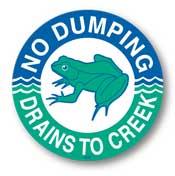 Contact Rick Bush Director of Public Works 1057 Dudley Street Sturgis, SD 57785 605.347.3916 Hours Monday - Thursday 6:00 am - 3:00 pm Friday 6:00 am - 10:00 am |
antifreeze fertilizers household chemicals paints pet waste solvents | detergents gasoline motor oil pesticides road salt yard waste |
Stormwater Management Plan
Per the Environmental Protection Act (EPA) website:
The Clean Water Act (CWA) establishes the basic structure for regulating discharges of pollutants into the waters of the United States and regulating quality standards for surface waters. The basis of the CWA was enacted in 1948 and was called the Federal Water Pollution Control Act, but the Act was significantly reorganized and expanded in 1972. "Clean Water Act" became the Act's common name with amendments in 1972.
Under the CWA, EPA has implemented pollution control programs such as setting wastewater standards for industry. EPA has also developed national water quality criteria recommendations for pollutants in surface waters.
The CWA made it unlawful to discharge any pollutant from a point source into navigable waters, unless a permit was obtained:
- EPA's National Pollutant Discharge Elimination System (NPDES) permit program controls discharges.
- Point sources are discrete conveyances such as pipes or man-made ditches.
- Individual homes that are connected to a municipal system, use a septic system, or do not have a surface discharge do not need a NPDES permit;
- Industrial, municipal, and other facilities must obtain permits if their discharges go directly to surface waters.
The City of Sturgis is categorized as a small MS4. In South Dakota, the Department of Agriculture and Natural Resources (SDDANR) is authorized to run the NPDES program. On March of 2003, the City of Sturgis submitted a Notice of Intent and was issued a General Permit from SDDANR.
As part of the General Permit, the City of Sturgis is required to develop, implement, and update a Stormwater Management Plan (SWMP). The plan must address and implement the following measures:
- Public education and outreach;
- Public participation/involvement;
- Illicit discharge detection and elimination;
- Construction site storm water runoff control;
- Post-construction storm water management; and,
- Pollution prevention/good housekeeping for municipal operations.
City of Sturgis Stormwater Management Plan
If you would like to report an illicit discharge of polluted storm water into one of the City’s drainages, or if you have any comments, concerns or suggestions in reference to stormwater management, please contact us.
For ways to help reduce stormwater pollution, see our Resources page for more information.
